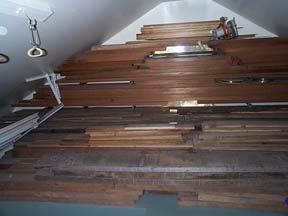Air-drying Wood
The best way to cure wood is air drying. The wood can be stacked with shims (called "stickering" in the trade) under a simple roof or in a shed, with no other protection. It will need to cure about a year per inch of thickness to get it down to about 15% moisture content. Then it must be stored in a shop or shed where the air is around 40% relative humidity. The wood will stabilize at 7-14% moisture content, which is ideal for lutherie.
Kiln drying is another method for drying, but this raises the temperature of the resins in the wood and seems to polymerize them. When the stringed instrument is being "played in" or "waked up," it is thought that the acoustic energy of the music vibrates the particles of resin in the wood's cells, pulverizing them to a dust that no longer dampens the sound. When wood is kiln-dried, these resins seem to be too hard to pulverize, and the wood remains dead, impervious to musical awakening. Likewise, if the tree is cut during spring or summer, when it is full of sap, curing will leave the cells full of resins. This wood also will not be susceptible to "waking up."
Another method of curing which is generating a lot of interest among luthiers is the"dehumidification kiln." As its name implies, the kiln is essentially a large dehumidifier build into a sealed room which is kept no warmer than about 110 degrees Fahrenheit. The wood's moisture content is brought down to 14% by a carefully controlled series of steps over several weeks, resulting in a very stable, dry wood without all the drawbacks mentioned above regarding conventional kiln drying. The jury is still mulling this one over...

